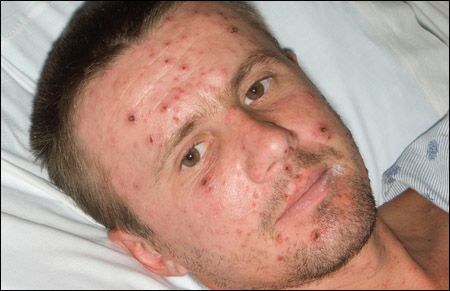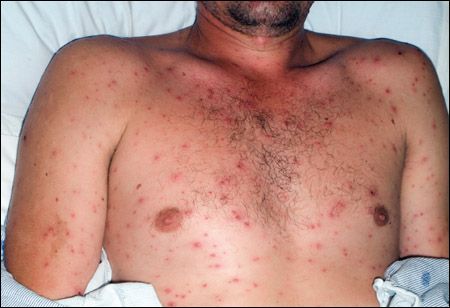Young Man With a Mildly Pruritic Generalized Rash
A 29-year-old Ukrainian man presents with a mildly pruritic generalized rash, which started 4 days earlier as a widespread eruption. The patient has no contacts who have a similar rash.

HISTORY
A 29-year-old Ukrainian man presents with a mildly pruritic generalized rash, which started 4 days earlier as a widespread eruption. The patient has no contacts who have a similar rash.
His dentist prescribed penicillin 7 days earlier for a dental infection, and 3 days later the rash developed. The patient was instructed to stop the penicillin and was switched to erythromycin 1 day before presentation.
The patient had emigrated from the Ukraine 7 months earlier; he reports that his immunizations are up-to-date. He has no history of abscesses, diabetes, sexually transmitted diseases, asthma, eczema, or a similar rash. He takes no other drugs or herbal medicines. He denies any drug allergies. Social history includes alcohol and tobacco use; however, he denies illicit drug use.
PHYSICAL EXAMINATION
Blood pressure is 131/75 mm Hg; pulse rate, 82 beats per minute; temperature (oral), 39.2°C (102.6°F); respiration rate, 16 breaths per minute; and oxygen saturation, 96% on room air.
The rash consists of multiple macules, papules, vesicles, and pustules on an erythematous base; some of the pustular areas show crusting. The vesiculopustular lesions are about 3 mm in diameter and contain clear fluid.
The rash involves the face, scalp, chest, back, arms, and legs; the palms, soles, and penis are spared. There is no predilection of the lesions to flexural areas or extensor surfaces.
Multiple small pustular lesions are noted on the buccal mucosa and soft palate, but no fissures or petechiae are evident on the oral mucosa. The rest of the physical findings are normal.
"WHAT'S YOUR DIAGNOSIS?"
ANSWER: VARICELLA (CHICKENPOX)

Figure 1 – This classic chickenpox rash consists of lesions in different stages of healing-from macules, to papules, to vesicles, to pustules, to crusting.
This patient had disseminated varicella. After further questioning, he reported that he had never had chickenpox and had never received the varicella vaccine.
VARICELLA: A BRIEF OVERVIEW
Clinical features. Primary varicella-zoster virus (VZV) infection is acquired by inhalation of airborne droplets or by direct contact with chickenpox lesions. Chickenpox is primarily a pediatric disease, although it can occur in adults.
Two weeks after a patient is exposed to respiratory droplets, a rash appears. The classic chickenpox rash is characterized by lesions in different stages of healing, as was this patient's rash (Figures 1 and 2). The lesions progress from macules, to papules, to vesicles, to pustules, to crusting. Vesicles may develop on the palms and soles, although this did not occur in this patient. Most patients with chickenpox are febrile.

Figure 2 – This close-up shows vesiculopustular lesions on an erythematous base.
Diangosis. The diagnosis can usually be made clinically. A Tzanck smear of the vesicular fluid will demonstrate multinucleated giant cells and intranuclear eosinophilic inclusion bodies; however, bear in mind that these findings are also associated with herpes simplex virus (HSV) infection. VZV infection can also be diagnosed with polymerase chain reaction (PCR)-based techniques on vesicular fluid. The results of this patient's PCR test were diagnostic of VZV infection.
Treatment. Chickenpox in adults is treated with oral acyclovir. In immunocompromised patients, intravenous acyclovir and varicella-zoster immune globulin may be used.
Complications.Because chickenpox can develop into varicella pneumonia, with significant morbidity and mortality, a chest radiograph should be obtained for any pregnant patient who has hypoxia. Another complication is disseminated varicella, which typically occurs in adults, as it did in this patient. Disseminated varicella may affect the liver, myocardium, and CNS. CNS involvement usually requires treatment with intravenous acyclovir.1
DIFFERENTIAL DIAGNOSIS
Herpes simplex virus infection. Primary oral HSV infection is characterized by cold sores on the lips as well as painful vesicles on the gingiva, palate, and tongue. The vesicles may be surrounded by erythema and edema. Outbreaks tend to be recurrent and are often associated with increased stress.
In men, genital herpes is characterized by painful erythematous vesicles on the penis that eventually ulcerate and crust; these vesicles may also be found on the anus and perineum. In women, the vesicles occur on the external genitalia, vagina, and cervix. Confirmatory testing can be done with PCR assay of vesicular fluid or by direct fluorescent antibody testing of the fluid.
Most HSV infections are selflimited. Oral acyclovir may be taken at the early onset of an outbreak to shorten its course.2
Disseminated HSV infection that involves most of the body is rare; it typically occurs in immunocompromised persons. These patients usually require inpatient treatment with intravenous acyclovir. HSV infection can also develop into HSV encephalitis. Lumbar puncture is required if this complication is suspected; it should be treated with intravenous acyclovir.
Dermatitis herpetiformis. This cutaneous disorder is caused by deposition of IgA in the papillary dermis, which causes an immunological reaction. It is thought to be associated with gluten sensitivity. The disease waxes and wanes throughout the patient's lifetime.
Unlike VZV or HSV infection, dermatitis herpetiformis does not occur in a dermatomal distribution. It usually presents with erythematous papules and vesicles that are symmetrically distributed over the extensor surfaces and are extremely pruritic.3 The diagnosis is made by skin biopsy. Dermatitis herpetiformis can be controlled with a gluten-free diet and with dapsone and sulfapyridine.
Impetigo. A superficial skin infection that usually occurs in children, impetigo is caused by Staphylococcus aureus or by group A β-hemolytic streptococci (GABHS). Nonbullous impetigo typically consists of pustules that develop into vesicles and honey-colored plaques. The initial lesions rapidly spread if not treated. Bullous impetigo is characterized by thin-roofed bullae that rupture in 24 to 48 hours and spread locally. Impetigo is accompanied by regional lymphadenopathy.4
The diagnosis is usually based on the history and physical findings. A confirmatory culture can be done if the presentation is atypical.
Treatment consists of removal of the honey-colored crusts and application of wet to dry dressings. Antibiotics are usually prescribed: topical agents, such as mupirocin, for mild cases; oral antibiotics for moderate cases; and intravenous therapy for severe cases. Complications of impetigo include cellulitis and acute poststreptococcal glomerulonephritis.
Rickettsialpox. This disease is caused by Rickettsia akari. The organism is transmitted by Liponyssoides sanguineus, which is a mite found most commonly on house mice. The mite bites humans when house mice are in short supply.
The incubation period is about 7 days after the bite. The disease starts as a papular skin lesion at the site of the bite, which develops into a vesicular lesion with surrounding erythema. The vesicles then lead to black eschar formation.
Less than 1 week after the initial skin lesion appears, constitutional symptoms, such as fever, develop. The local lesion then disseminates into a generalized papulovesicular rash about 3 days after the onset of constitutional symptoms. The rash may involve the mucous membranes, palms, and soles. The lesions generally do not leave any scars, and the disease is not contagious.5
The diagnosis is based on the history and physical findings. A confirmatory direct fluorescent antibody test of skin lesions can be done in atypical cases. The disease is self-limited and lasts for 2 to 3 weeks; however, antibiotics-usually doxycycline-are often given to hasten its resolution. The prognosis is excellent; associated complications and mortality are extremely rare.
References:
REFERENCES:
1.
Choo PW, Donahue JG, Manson JE, Platt R. The epidemiology of varicella and its complications.
J Infect Dis
. 1995;172:706-712.
2.
Cockerell C. Diagnosis and treatment of cutaneous herpes simplex virus infections.
West J Med
. 1996;164:518-520.
3.
George DE, Browning JC, Hsu S. Medical pearl: dermatitis herpetiformis-potential for confusion with eczema.
J Am Acad Dermatol
. 2006;54:327-328.
4.
Darmstadt GL, Lane AT. Impetigo: an overview.
Pediatr Dermatol
. 1994;11:293-303.
5.
Heymann WR. Rickettsialpox.
Clin Dermatol
. 1996;14:279-282.